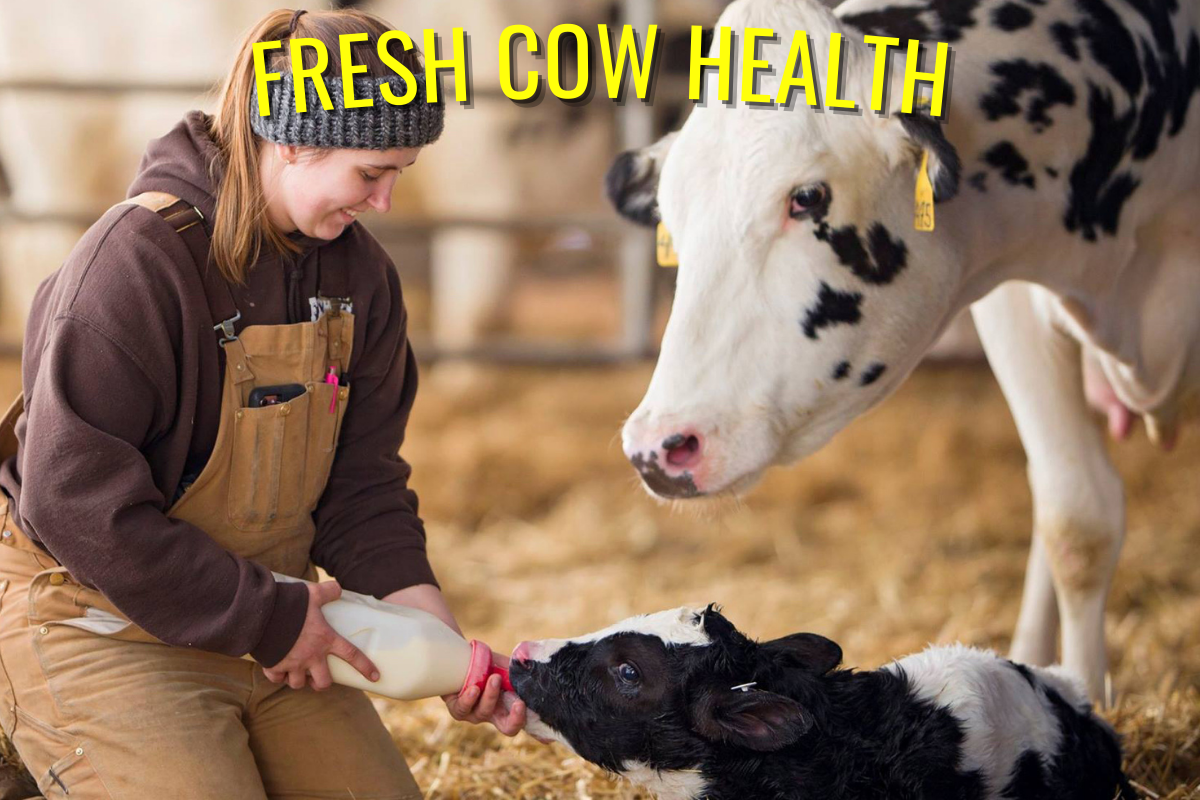Calving is a stressful event for both the cow and the calf. Management practices that minimize stress and support immune function are crucial during this event. The first few days postpartum are the most critical days in the life of a dairy cow. Proper nutrition and management during this time is important to maintain immunity, prevent metabolic disorders, and achieve high milk production throughout lactation.
Metabolic Disorders
A metabolic disorder is a result of a disruption in the cow’s internal biochemical processes. These disorders are often caused by an imbalance of minerals in the blood or improper rumen pH. Cows that experience a metabolic disorder are less productive and more likely to encounter a secondary disorder such as; ketosis, mastitis, retained placenta and uterine prolapse.
Rumen Acidosis
Cause: Acidosis is caused by a drop of pH in the rumen. Signs of rumen acidosis include; going off feed, slug feeding, depressed milk fat, diarrhea, laminitis, and a high incidence of displaced abomasum. Acidosis is often caused by poor bunk management or low-quality ration forage.
Low rumen pH is often common in fresh cows as their intakes increase or decrease dramatically, or as they change to a new ration higher in fermentable carbohydrate. This low rumen pH makes the fresh cow more likely to experience acidosis than cows later in lactation.
Prevention: Properly balance diets for energy, and provide smooth transitions from the close-up ration, to the fresh cow ration, and on to the high cow ration. It is also a good idea to offer rumen buffers free choice and/or in the ration.
Milk Fever
Cause: Milk Fever is a result of hypocalcemia (low blood calcium). Typically, cows will experience hypocalcemia post calving because of increased demand for calcium as the cow produces more milk. In some cases, the change is more drastic and hypocalcemia is severe enough to lead to clinical milk fever.
This sudden demand for calcium must be accommodated by absorption from the gut or resorption (mobilization) from bone. When calcium supplied from both gut absorption and bone mobilization is not adequate, then milk fever is the result.
Prevention: Consider feeding a negative DCAD diet in the close-up period, and ensure the fresh cow diet is properly balanced. It is also common to supply the cow with an oral calcium supplement at calving as a preventative measure.
Displaced Abomasum
Cause: A displaced abomasum (DA) usually occurs within the first month after calving,
and may be a primary or secondary condition. The abomasum migrates to the left or right side, and the gut may become twisted and create a partial blockage of the digestive tract. Fresh cows with low dry matter intake, or those whose ration is changed abruptly are more at risk of a DA.
Prevention: Maintain adequate daily dry matter intake, and blood acid-base balance. Watch for any symptoms of milk fever and promptly treat with intravenous calcium if needed.
Ketosis
Cause: Ketosis occurs when the cow experiences a negative energy balance and the body mobilizes large amounts of adipose (fat) tissue. Fat mobilization is accompanied by high blood serum concentrations of non-esterified fatty acids (NEFAs), a large portion of which are directed to ketone synthesis in the liver. Resulting in high concentrations of NEFAs and ketones, and low concentrations of glucose in the cow.
Prevention: Manage body condition in late lactation, heavy cows are more likely to experience ketosis at freshening. Encourage DMI during the close-up and fresh cow periods, and balance rations for both adequate energy and fiber to promote rumen health. Consider including supplements such as; niacin, calcium propionate, sodium propionate, propylene glycol, and rumen-protected choline, during the close-up period as they may help prevent and manage ketosis.
There are many different metabolic diseases that fresh cows are at risk for. One thing that they all have in common is that to prevent them from occurring cows need properly balanced rations and we have to keep the cow eating! If the close-up ration is adequately balanced and the fresh cow ration mirrors the high cow ration, fresh cows should experience a relatively smooth transition.
However, there are additional supplements to consider when promoting gut health to keep cows eating and also to support to the immune system through transition. Yeast, probiotics, and chelated minerals have all been shown to promote optimum rumen function and improve overall cow health. One supplement that has all the bases covered is Achieve.
Achieve contains:
-
Multiple strains of live yeast that provide a rich nutrient source for rumen microbes.
-
Viable lactobacillus probiotics aid in stabilizing rumen pH and helping to prevent acidosis.
-
Bacillus subtilis to produce large quantities of digestive enzymes and compete with pathogenic bacteria.
-
Digestive enzymes that stimulate fiber-digestion, stabilize rumen pH, and reduce heat stress.
-
Mannan-oligosaccharide prevents pathogenic colonization in the GI tract.
-
Yucca schidigera modifies ruminal fermentation by altering select microorganism ratios. Resulting in reduction of rumen ammonia and high blood urea levels. Which in turn has been show to improve milk production and conception rates in dairy cattle.
-
Immune Positioning System (IPS) a blend of biologically active polysaccharides and polypeptides. IPS nutritionally assists cows in balancing cellular function, reducing gut inflammation, and supporting the immune system.
Visit with your veterinarian and nutritionist about any management improvements, or ration adjusts that may aid in reducing metabolic disease in your transition cows.
Written by: Mariah Gull, M.S.

